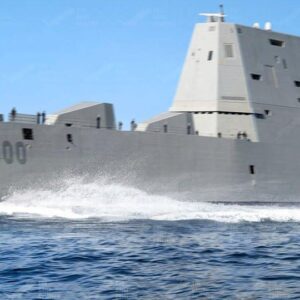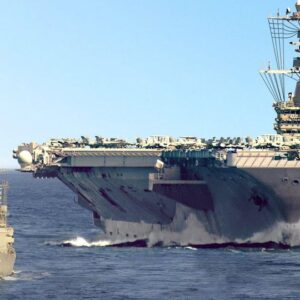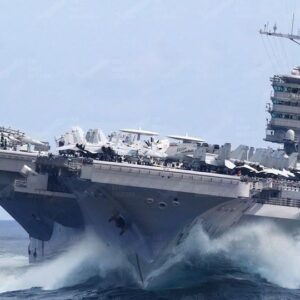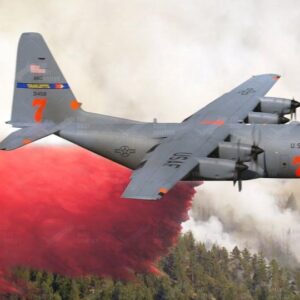The Admiral Graf Spee was a German “pocket battleship” that played a significant role during the early stages of World War II, most notably in disrupting Allied merchant shipping.

The ship is perhaps best known for the Battle of the River Plate in December 1939, where it engaged a squadron of British cruisers before seeking refuge in a neutral port in Uruguay.
The Graf Spee’s story ended dramatically when its captain, Hans Langsdorff, made the strategic decision to scuttle the ship, thus denying its capture or destruction by the British forces.
Construction
The restrictions placed on Germany by the Treaty of Versailles following World War I significantly impacted the construction of their naval fleet, including the Graf Spee.
The treaty allowed Germany to build ships with a maximum displacement of 10,000 tons, approximately the size of a light cruiser in most navies.
However, the German engineers used this constraint as a driving force for innovation, leading to the design of the unique ‘pocket battleship.’
The Deutschland-class “pocket battleships,” as this new breed of ships were known, were a creative response to the treaty’s limitations.
They had the firepower to engage with heavily armed opponents and the speed to evade those they couldn’t outgun.
This presented a new strategic paradigm, effectively enabling these vessels to punch above their weight class.
 Admiral Graf Spee in 1936.
Admiral Graf Spee in 1936.
To enhance the ship’s speed and range without sacrificing firepower, the designers turned to advanced technologies and engineering practices.
The ship’s hull was made using electric welding instead of traditional riveting, which reduced the weight and increased structural strength.
This novel approach made the Graf Spee significantly lighter and therefore faster than it would have been using traditional construction techniques.
The propulsion system of the Graf Spee was another highlight of its design. The ship was powered by eight MAN diesel engines, a departure from the typical steam turbines used in many warships of that era. These engines not only provided the Graf Spee with a top speed of over 28 knots but also gave it an extended operational range.
The ship also featured eight 150 mm guns, eight 105 mm anti-aircraft guns, and carried multiple torpedo tubes and aircraft for reconnaissance and attack.
The Graf Spee In World War II
With the onset of World War II, the German Cruiser Admiral Graf Spee transitioned from a symbol of peaceful diplomacy to a fearsome predator on the high seas.
Commanded by the seasoned naval officer Captain Hans Langsdorff, the Graf Spee was tasked with commerce raiding – disrupting the vital supply lines of the Allied forces by attacking their merchant shipping.
The strategic location of the Graf Spee, stationed in the South Atlantic and Indian Oceans, allowed it to strike at the lifelines of the Allies, significantly affecting their war effort.
The vastness of the oceans provided the Graf Spee with ample room to maneuver and hide, making it difficult for the Allies to locate and engage the ship.
From September to December 1939, the Graf Spee conducted a highly effective commerce raiding campaign.
 The Admiral Graf Spee had an overall length of 186 meters (610 feet) and a beam (width) of approximately 21.65 meters (71 feet). Image by Bundesarchiv CC BY-SA 3.0
The Admiral Graf Spee had an overall length of 186 meters (610 feet) and a beam (width) of approximately 21.65 meters (71 feet). Image by Bundesarchiv CC BY-SA 3.0
The ship managed to sink nine ships, a total of over 50,000 tons, without suffering any damage or loss of life.
This was primarily due to Captain Langsdorff’s strategy of adhering to the “prize rules,” a set of regulations that ensured the safety of the crews of the merchant vessels before sinking their ships.
However, the Graf Spee operated under a strict directive from Admiral Raeder, the Commander-in-Chief of the German Navy.
Raeder’s orders were clear: the Graf Spee was to avoid engaging with enemy warships of equal or superior strength.
This directive was in place to ensure the longevity of the ship’s campaign and to avoid unnecessary risk. The Graf Spee, for all its formidable firepower, was still significantly outgunned by a full-sized battleship.
While this approach was tactically sound, it ultimately had a considerable impact on the Graf Spee’s fate in the Battle of the River Plate, where it found itself engaged with a force of three British cruisers.
The balance of firepower, combined with the orders to avoid such engagements, led to a pivotal moment in the history of the Graf Spee, and indeed, the early stages of the Second World War.
The Battle Of The River Plate
The Battle of the River Plate, fought off the coast of Uruguay on December 13, 1939, marked a pivotal point in the Admiral Graf Spee’s wartime campaign and the first major naval battle of World War II.
The confrontation was a classic naval showdown between the pocket battleship and a force of three British cruisers—HMS Exeter, Ajax, and Achilles.
The British Royal Navy had set a trap for the Graf Spee, forming a hunting group, also known as Force G, to track down and engage the German raider.
Commanded by Commodore Henry Harwood, the group correctly deduced the Graf Spee’s next target would be the area around the River Plate, the estuary formed by the confluence of the Uruguay River and the Paraná River.
When the Graf Spee encountered the British squadron, it was far from its home base and support.
Despite being outnumbered, the Graf Spee held a significant firepower advantage. It engaged the British cruisers, severely damaging the Exeter and forcing the Ajax and the Achilles to withdraw temporarily.
The intense confrontation led to casualties on both sides, with the Graf Spee also sustaining damage.
Despite the damage inflicted on the British cruisers, Captain Langsdorff of the Graf Spee found himself in a difficult situation.
His orders from Admiral Raeder were clear: avoid unnecessary risk and do not engage superior enemy forces. With the Exeter critically damaged and the other two cruisers temporarily at bay, he faced a tough decision.
Convinced that a larger British force was likely en route, Captain Langsdorff made a critical decision: to seek refuge and carry out necessary repairs in the neutral port of Montevideo, Uruguay.
According to international law, the Graf Spee could only remain in neutral waters for 72 hours.
This period was not enough to carry out extensive repairs, and the British did everything in their power diplomatically to ensure the damaged ship could not escape easily.
Scuttling Of The Graf Spee
The scuttling of the Admiral Graf Spee, on December 17, 1939, marked a dramatic end to the operational life of this formidable warship.
Captain Hans Langsdorff, under immense pressure and facing seemingly insurmountable odds, made the difficult decision to scuttle his ship, effectively sacrificing the Graf Spee to avoid its capture or destruction by the enemy.
Having sought refuge in the port of Montevideo, Uruguay, for repairs after the Battle of the River Plate, the Graf Spee was subject to the constraints of international law.
As a neutral country, Uruguay gave the ship a sanctuary for 72 hours, after which it would have to leave or face internment.
This window of time was insufficient to make the necessary repairs to the heavily damaged ship, which compounded the problem faced by Captain Langsdorff.
To make matters worse, the British, using misinformation and diplomatic pressure, convinced Langsdorff that a formidable British fleet, including an aircraft carrier and several battleships, awaited the Graf Spee’s exit from the neutral port.
In reality, only the two light cruisers Ajax and Achilles and the damaged heavy cruiser Exeter, which had already engaged Graf Spee, were nearby.
But the British bluff worked, and Langsdorff was left in a predicament.
The fate of the Graf Spee was effectively sealed. If the ship left the port, it would most likely be destroyed by the supposedly waiting British force.
If it stayed beyond the stipulated time, it would be interned by Uruguay, effectively taking it out of the war.
Either way, the Allies would score a significant victory.
Faced with these grim prospects, Langsdorff made a strategic sacrifice. He chose to scuttle the Graf Spee, denying the Allies the symbolic victory of capturing or sinking the ship.
With a skeleton crew aboard, the Graf Spee was moved to the outer roadstead off Montevideo.
There, charges that had been placed onboard were detonated, and the ship was scuttled, sinking into the shallow waters of the River Plate estuary.
Aftermath
The Graf Spee’s crew was taken into custody by the Uruguayan authorities after the ship was scuttled.
They were interned in Argentina, a nation that was neutral but sympathetic to the German cause.
The internment lasted for the remainder of the war, effectively preventing these sailors from rejoining the conflict.
 The Admiral Graf Spee after it was scuttled.
The Admiral Graf Spee after it was scuttled.
The crew was treated respectfully and was even allowed to hold a funeral for their fallen comrades, including Captain Langsdorff, who took his own life three days after the scuttling, reportedly laying on the ship’s battle ensign in his final moments.
Langsdorff’s decision to scuttle the Graf Spee to save his crew’s lives rather than to engage in a potentially futile battle with the British won him admiration from both his own men and his enemies.
His actions epitomized the principle of maintaining the dignity and value of human life even in the face of war, a stance that has been remembered and respected to this day.
From a strategic perspective, the loss of the Graf Spee was a significant blow to the German commerce raiding strategy. This pocket battleship had been remarkably successful in disrupting Allied shipping.
The ship’s demise limited the number of surface vessels available to Germany for such operations, placing a greater burden on U-boats for maintaining the maritime blockade against Britain.
On the other hand, the scuttling was a significant morale boost for the Allies. Despite the Graf Spee not being captured or sunk in battle, its destruction was still seen as a victory.
It showed that the formidable German navy could be challenged and defeated, setting the stage for future confrontations.
Why did the Graf Spee sink?
The Graf Spee sank because, after a battle, it was damaged and had to go to the port in Montevideo, Uruguay.
The ship’s commander, Hans Langsdorff, heard false reports that strong British naval forces were coming. Believing this, he decided to scuttle, or intentionally sink, the Graf Spee.
The Wreckage Of The Graf Spee
After being scuttled in the estuary of the River Plate, the Admiral Graf Spee became a maritime relic. Much of the ship’s wreckage remained partially submerged for several decades.
For some time after its scuttling, the Graf Spee was considered a hazard to navigation due to its location. The ship’s top superstructure, including the tops of the gun turrets and the mast, remained visible above the waterline.
In the years following World War II, some initial salvage operations were conducted. The most visible parts of the wreck were scrapped to reduce the danger to other vessels navigating the river.
However, the majority of the Graf Spee remained undisturbed until the early 21st century when more extensive salvage efforts were initiated. These operations were led by a team of private salvors under the leadership of businessman Alfredo Etchegaray.
The salvage team faced significant technical challenges due to the ship’s size, weight, and the conditions at the bottom of the estuary.
One of the most notable salvage operations occurred in 2004 when one of the ship’s 150-ton gun turrets, known as “Anton”, was raised. The turret contained a 283 mm (11 in) gun.
The salvaging of the rangefinder from the ship’s command tower in 2006 was another significant event.
The rangefinder, an optical device for determining the distance from the ship to its target, was a critical part of the Graf Spee’s targeting system.
 The salvaged rangefinder. Image by Tano4595
The salvaged rangefinder. Image by Tano4595
The recovered artifacts underwent preservation work to mitigate the damage caused by their prolonged immersion in water.
Today, these artifacts, including the rangefinder and parts of the ship’s telemetric equipment, are on display at the National Marine Museum in Montevideo, Uruguay.
They serve as historical artifacts, providing tangible links to the Graf Spee’s past.





